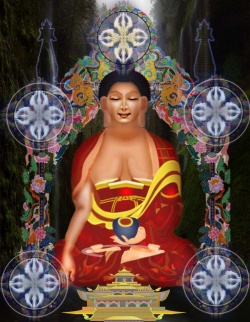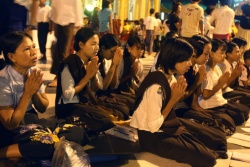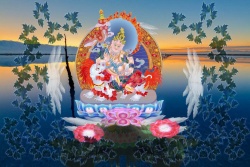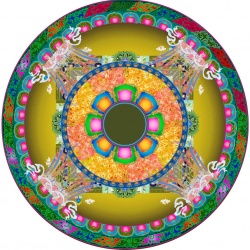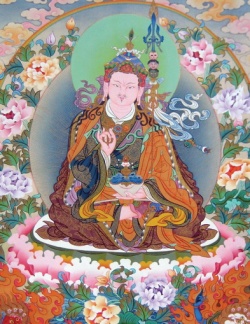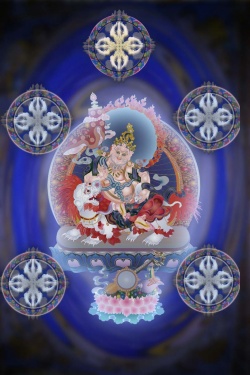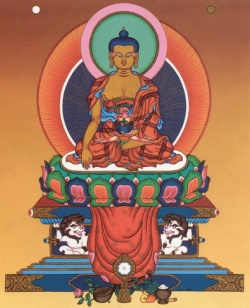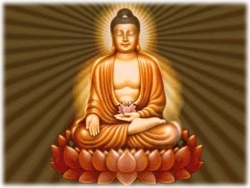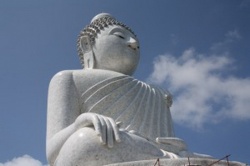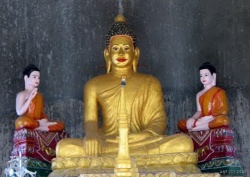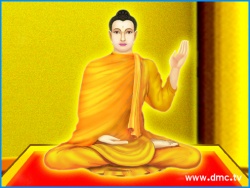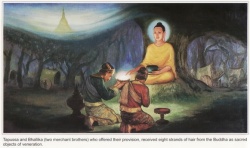Prajñā
Prajñā (प्रज्ञा) or paññā(Pāli) in Buddhism is Wisdom, understanding, discernment, insight, or cognitive acuity.
It is one of Threefold_training of the Noble Eightfold Path.
Such Wisdom is understood to exist in the universal flux of being and can be intuitively experienced through meditation.
In some sects of Buddhism, it is especially the Wisdom that is based on the direct realization of such things as the four noble truths, impermanence, interdependent origination, non-self and emptiness.
Prajñā is the Wisdom that is able to extinguish afflictions (kleśas) and bring about enlightenment.
Prajñā (般若, 734–?) was from Kophen (罽賓), an ancient kingdom also called Gandhāra, in present-day Kashmir, northern Pakistan, and eastern Afghanistan area.
He became a novice monk at seven and was fully ordained at twenty.
When he was twenty-three, he went to Nālandā Monastery in central India and studied, under great masters, the Yogācāra doctrine, the middle view versus the opposite views, the Diamond Sūtra, and more.
Then he visited nations across the South China Sea.
\In 781, the second year of the Jianzhong (建中) years of Emperor Dezong (唐德宗) of the Tang Dynasty (618–907), he arrived in Guangzhou (廣州), Guangdong Province.
He then went to Chang-an (長安), the capital city, and started translating Sanskrit texts into Chinese.
In 788, the fourth year of the Zhenyuan (貞元) years, he translated the Sūtra of the Six Pāramitās in the Tenets of the Mahāyāna (T08n0261) in 10 fascicles. Two years later, he was sent as an envoy to Kaśmīra, present-day Kashmir.
He was soon given the title Prajñā Tripiṭaka Master, and awarded the purple robe.
In 795, the eleventh year of the Zhenyuan years, the king of Oḍra, present-day Indian state Odisha, sent as a tribute the Sanskrit text of the 40-fascicle version of the Mahāvaipulya Sūtra of Buddha Adornment, copied by his own hand.
The following year, Prajñā began to translate it into Chinese and finished in 798. His translation, in text 293 (T10n0293), was reviewed and edited by Dharma masters Chengguan (澄觀, 738–839), Yuanzhao (圓照, dates unknown), and others.
Then he translated the Heart Sūtra (T08n0253) and the Mahāyāna Sūtra of the Observation of the Original Mind Ground (T03n0159).
Prajñā died in the city of Luoyang (洛陽), his age unknown. He was buried on the Eastern Heights of the Longmen Caves (龍門西岡).
Etymology
In Sanskrit, jñā can be translated as "consciousness", "knowledge", or "understanding." Pra is an intensifier which could be translated as "higher", "greater", "supreme" or "premium."
In the Pāli Canon
In the Pāli Canon, paññā is defined in a variety of overlapping ways, frequently centering on concentrated insight into the three characteristics of all things—impermanence, suffering and no-self—and the four noble truths.
For instance, both when elaborating upon the five spiritual faculties—faith,
concentration and Wisdom—and when discussing the threefold training of higher virtue (adhi-Sīla),
higher-mind (adhi-Citta) and
higher-Wisdom (or "heightened discernment": adhi-paññā),
The Buddha describes paññā (here translated as "discernment") as follows:
- And what is the faculty of discernment?
There is the case where a Monk, a disciple of the noble ones, is discerning, endowed with discernment of arising and passing away—noble, penetrating, leading to the right ending of stress.
He discerns, as it is actually present, [the Four Noble Truths): "This is stress... This is the origination of stress... This is the cessation of stress...
This is the path of practice leading to the cessation of stress." This is called the faculty of discernment.
In a subsequent discourse regarding the threefold training,
The Buddha indicates that higher Wisdom entails the application of concentration and insight to end "fermentations" (or "mental intoxicants"; Pāli: āsava), effectively achieving arahantship:
- And what is the training in heightened discernment?
There is the case where a Monk, through the ending of the mental fermentations, enters and remains in the fermentation-free awareness-release and discernment-release, having known and made them manifest for himself right in the here and now.
This is called the training in heightened discernment.
In mapping the threefold training to the noble eightfold path, paññā is traditionally associated with right view (sammā-diṭṭhi) and right resolve (sammā-saṅkappa) which The Buddha defined:
- And what, monks, is right view? Knowledge with regard to stress, knowledge with regard to the origination of stress, knowledge with regard to the stopping of stress, knowledge with regard to the way of practice leading to the stopping of stress:
This, monks, is called right view.
And what is right resolve? Being resolved on renunciation, on freedom from ill will, on harmlessness:
This is called right resolve.
From the Visuddhimagga
In the 5th-century exegetic Visuddhimagga, Buddhaghoṣa states that the function of paññā is "to abolish the darkness of delusion" and that it is "manifested as non-delusion." Its proximate cause is concentration.
Buddhaghoṣa provides the analogy of a tree to discuss the development of paññā:
- The soil of the tree are the:
- The roots are:
- The trunk is made up of:
- purification of view
- purification by overcoming doubt
- purification by knowledge and vision of what is and is not the path
- purification by knowledge and vision of the way
- purification by knowledge and vision.
Buddhaghoṣa instructs that, to achieve paññā, one should first learn about the soil, then the roots and then the trunk.
Buddhist scholar, Paul Griffiths, offers the following summary of Buddhaghoṣa's definition of paññā:
- Buddhaghosa ... defines for us with some precision exactly what Wisdom is:
"Wisdom has the characteristic (lakkhaṇa) of penetrating the defining essence of things (dhammasabhāvapaṭivedha);
its function (rasa) is to abolish the darkness of delusion (mohandhakāra-viddhaṇsana) which obscures the defining essence of things;
its manifestation (paccupaṭṭhāna) is absence of delusion (asammoha).
Because of the words: 'One who is concentrated knows and sees things as they really are' (''samāhito yathābhūtaṃ jānāti passati), concentration is its immediate cause (padaṭṭhāna)" (14.7).
The key term in this definition is yathābhūta, combined very frequently throughout the Pali literature with ñāṇa or dassana.
Translated somewhat freely as "knowledge or vision in accordance with reality," this is the full and proper definition of paññā, Wisdom, the desired aim of the man who practices insight meditation.
Such a man can see the defining essence, the own-being (Sabhāva) of everything, and his vision is no longer obscured by the threefold fault of passion (Rāga), hatred (dosa), and delusion (Moha).
From the Prajñā-pāramitā Sutras
The Prajñā-pāramitā Sutras, such as The Heart Sutra, describe prajñā as supreme, highest, incomparable, unequalled and unsurpassed. It is spoken of as the principal means, by its Enlightenment, of attaining nirvāna, through its revelation of the true nature of all things.
The beginning of The Heart Sutra includes the phrase "...doing prajñā..." indicating that prajñā is also an activity as well as an outcome, quality or state.
As activity, prajñā can be described as "choiceless engagement" where "choiceless" means selflessly accepting outcomes as they develop while understanding interdependent co-existence and emptiness (śūnyatā), followed by further engagement.
Huineng and the practice of Wisdom
In the history of Zen Buddhism, the Sixth Patriarch Huineng (d. 713) emphasized the practice ofprajñā in counterpoint to the quietistic and self-absorbed style of meditation that was then current.
In so doing, he emphasized dynamic action and human involvement as essential to Zen practice.
As a Perfection
Paññā is also listed as the fourth virtue of ten Theravāda pāramitās and prajñā is the sixth of the six Mahāyāna pāramitās.
Three prajñās or mūla prajñā
Norbu et al. render the mūla prajñā (Sanskrit) where mūla may be set into English as "root" (as of a tree), thus:
- Reflection (Pali: cintāmayā paññā, Sanskrit: cintā, Tibetan: sam+ pa)
In an article on Vipassana Research Institute, these three sources of panna are explained as followed.
- Cintāmayā paññā is the Wisdom obtained from one's own thinking, not just from hearing others (parato asutva patilabhati).
It is the understanding of impermanence, Suffering and essencelessness, from what one has grasped by the means of one's own intellect.
It is the process of intellectually analyzing something to see whether it is logical and rational.
Having gone through such a process, one can then accept a teaching intellectually.
One may thereby become knowledgeable about the theory of Dhamma, and may be able to explain it to others.
One may even be able to help others realize the fact of anicca, Dukkha and Anatta, but still one cannot obtain liberation for oneself.
On the contrary, there is a danger that one may accumulate more mental defilements by developing ego since one lacks the direct experience of Wisdom.
Sometimes we find in the texts a change in the order of sutamayā paññā and cintāmayā paññā.
At times cinta-maya panna is mentioned first, followed by suta-maya panna and Bhavana-maya panna.
At times, suta-maya panna is followed by cinta-maya panna and Bhavana-maya panna.
But in both cases, Bhavana-maya panna comes at the end and is of prime importance for the realisation of truth.
It does not make any difference in which order we find the first two.
Initially a person may listen to the Dhamma from an outside source- suta-maya panna, and then develop cinta-maya panna by rationally thinking about it, trying to understand anicca, Dukkha and Anatta intellectually, and thereby develop yoniso Manasikara (right thinking).
Or one may start with cinta-maya panna, one's own intellectual understanding, by reflecting rationally on anicca, Dukkha and Anatta, and then, by listening to others (suta-maya panna), one may confirm one's intellectual understanding.
We should remember that whichever of the two may come first, neither of them can give liberation. Liberation results only from Bhavana-maya panna.
Bhāvanāmayā paññā is the Wisdom obtained by meditation -- the Wisdom that comes from the direct experience of the truth.
This development of insight is also called vipassana-Bhavana (Vipassana meditation).
The meditator makes right effort and so realizes for himself that every thing in the world is transitory, a source of Suffering, and essenceless.
This insight is not the mere acceptance of what someone else has said, nor the product of deductive reasoning.
It is, rather, the direct comprehension of the reality of anicca, Dukkha and Anatta.
To develop Bhāvanā mayā paññā, we must experience all phenomena and understand their true nature.
And this is done through experiencing Vedana, (bodily sensations), because it is through these sensations that the totality of our nature manifests itself as pancakkhandha (the (five aggregates).
These three aspects are the mūla prajñā of the sādhana of Prajñā-Pāramitā, the "pāramitā of Wisdom".
Hence, these three are related to, but distinct from, the prajñāpāramitā that denotes a particular cycle of discourse in the Buddhist literature, that which relates to the doctrinal field (Sanskrit: kṣetra) of the second turning of the Dharmachakra.
Gyatrul (b.1924), in a purport to the work of Chagmé (Wylie: Karma-chags-med, fl. 17th century), rendered into English by Wallace, conveying the importance of internalizing and integrating the doctrine by extending the metaphor, states:
Rather, apply Dharma by means of hearing, thinking, and meditating.
One of these alone is not enough.
All three must be practiced.
If you lack hearing and thinking, you are not in a good position to meditate effectively.
Such meditation is like trying to climb a mountain without your hands. However much you learn of the Dharma, practice it with faith and compassion.
In a commentary to Rangjung Dorje's Namshe Yeshe Gepa (Wylie: rnam shes ye shes ‘byed pa) by Khenchen Thrangu Rinpoche rendered into English by Peter Roberts (2001), the mūla prajñā are discussed thus:
We need a very clear and profound conviction that The Buddha's teachings are correct and this is gained by using analysis and our own intelligence.
Therefore, after our teacher has taught us the path, we should analyze and thoroughly contemplate the teachings, and so gain the second type of understanding, which arises from this contemplation.
This understanding based on listening and contemplation is not enough; this alone cannot transform our mind.
The final transformation is accomplished by the practice of meditation.


